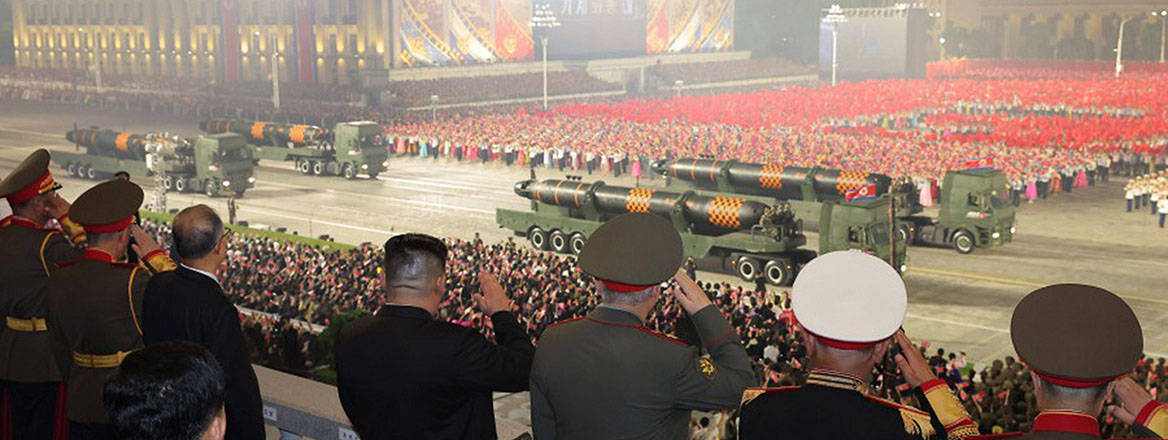Profiting from Proliferation? North Korea’s Exports of Missile and Nuclear Technology
This paper examines North Korean onward proliferation of missile and nuclear technology, based on a review of Pyongyang’s recent technological advancements and developments in North Korea’s customer base. The authors assess the likelihood of North Korea selling its missile and nuclear technology onwards, and the kinds of technology that may be for sale and to whom.
The September 2023 meeting between Russian President Vladimir Putin and North Korean leader Kim Jong-un raised concerns over the possibility that Pyongyang may supply Moscow with arms to support its war of aggression in Ukraine. Subsequent reports of North Korean transfers of ammunition to Russia and unconfirmed intelligence of suspected ballistic missiles transfers solidified those concerns. While the fact of Russia – host to one of the world’s most capable military–industrial complexes – turning to North Korea for arms was shocking, it did not come as a surprise to those familiar with the latter’s long history of arms trading and missile proliferation activities.
North Korea has exported missile technology since the 1980s and has, on several occasions, also transferred technology directly relevant to the development of nuclear weapons. Despite the introduction since 2006 of a progressively extensive sanctions regime against North Korea and its proliferation activity by the UN Security Council (UNSC), North Korean exports of missile and nuclear technology have persisted. Considering developments in North Korea’s nuclear and missile capabilities in recent years, the range of technologies that Pyongyang may be able to offer potential customers has also expanded. These technological advances, combined with the expansion of the UNSC sanctions regime over the past two decades, as well as other recent developments – like North Korea’s apparently expanding military collaboration with Russia, Moscow’s increasing disregard for UN sanctions, and North Korea’s reopening after the Covid-19 pandemic – make a reassessment of North Korea’s missile and nuclear exports timely.
This paper builds on existing literature on North Korea’s missile and nuclear proliferation, supplementing it with expert interviews and leveraging the emergence of new information and cases related to North Korea’s nuclear and missile capabilities and transfers over the past decade. The authors consider the potential for future missile and nuclear sales by Pyongyang, asking: how likely is North Korea to sell its missile and nuclear technology onwards, what technology may be for sale, and to whom? With a growing technological offering and a continuing need to generate hard currency, incentives for North Korea to sell its missile, nuclear and dual-use technologies to foreign customers persist. As well as North Korea’s more novel technologies potentially being for sale, Pyongyang’s technological progress may also have created surpluses of older technology which it may be looking to sell off.
However, despite clear supply-side drivers, there are a range of restraining factors that are likely to prevent an all-out onward proliferation bonanza emanating from North Korea. A variety of factors have whittled down the potential markets for these technologies, while the restrictive sanctions landscape and unprecedented monitoring of the Korean peninsula have also worked to reduce opportunities for sales and increase the risks posed by interdiction. North Korean concerns over the possibility of its more advanced capabilities falling into adversary hands, thus potentially putting its own deterrent at risk, are also likely to temper its willingness to export such capabilities, despite the potentially high price tag that could be attached to them.
The changing geopolitical landscape resulting from Russia’s invasion of Ukraine may, however, open new opportunities for North Korea. Russia’s willingness to engage in military trade with North Korea could give other countries the green light to accept North Korean arms, missiles and perhaps even nuclear technology. There remains a real risk of a broader collapse of the UNSC sanctions regime and the resurgence of North Korea’s arms and missile export enterprise.
Building on the analysis of North Korea’s expanded technological offering, reduced customer base and other factors affecting export decisions – and the clear need to pay attention to the issue – this paper presents 10 recommendations to help in countering North Korean missile and nuclear technology proliferation. These recommendations are organised in two categories, which attempt to address the supply side of the problem – deterring, dissuading and encouraging North Korea to refrain from engaging in onward proliferation – as well as demand-side factors – by trying to reduce North Korea’s customer base.
The authors would like to thank the Korea Foundation for the financial support that made this paper possible.
WRITTEN BY
Dr Daniel Salisbury
Guest Contributor
Darya Dolzikova
Senior Research Fellow
Proliferation and Nuclear Policy
- Jim McLeanMedia Relations Manager+44 (0)7917 373 069JimMc@rusi.org



